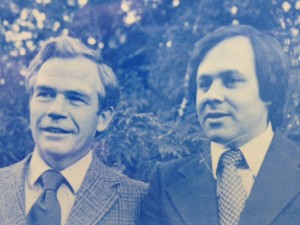
This is the second post in our series on the Voucher Left.
Way back in 1978, when Bee Gees ruled the radio and kids dumped pinball for Space Invaders, a couple of liberal Berkeley law professors were promoting a variation on “universal” school vouchers that they believed would ensure equity for the poor. Along the way, they foreshadowed a revolutionary twist on parental choice that would make national headlines nearly four decades later.
 John E. “Jack” Coons and Stephen Sugarman didn’t use the term “education savings accounts” in their book, “Education by Choice.” But they described a sweeping plan for publicly funded scholarships in terms familiar to those keeping tabs on ESAs. They envisioned parents, including low-income parents, having the power to create “personally tailored education” for their children, using “divisible educational experiences.”
John E. “Jack” Coons and Stephen Sugarman didn’t use the term “education savings accounts” in their book, “Education by Choice.” But they described a sweeping plan for publicly funded scholarships in terms familiar to those keeping tabs on ESAs. They envisioned parents, including low-income parents, having the power to create “personally tailored education” for their children, using “divisible educational experiences.”
To us, a more attractive idea is matching up a child and a series of individual instructors who operate independently from one another. Studying reading in the morning at Ms. Kay’s house, spending two afternoons a week learning a foreign language in Mr. Buxbaum’s electronic laboratory, and going on nature walks and playing tennis the other afternoons under the direction of Mr. Phillips could be a rich package for a ten-year-old. Aside from the educational broker or clearing house which, for a small fee (payable out of the grant to the family), would link these teachers and children, Kay, Buxbaum, and Phillips need have no organizational ties with one another. Nor would all children studying with Kay need to spend time with Buxbaum and Phillips; instead some would do math with Mr. Feller or animal care with Mr. Vetter.
Coons and Sugarman were talking about education, not just schools, in a way that makes more sense every day. They wanted parents in the driver’s seat. They expected a less restricted market to spawn new models. In “Education by Choice,” they suggest “living-room schools,” “minischools” and “schools without buildings at all.” They describe “educational parks” where small providers could congregate and “have the advantage of some economies of scale without the disadvantages of organizational hierarchy.” They even float the idea of a “mobile school.” Their prescience is remarkable, given that these are among the models ESA supporters envision today.
It’s also noteworthy given a rush to portray education savings accounts as right-wing.
In June, for example, the Washington Post described the creation of the near-universal ESA in Nevada as a “breakthrough for conservatives.” School choice would likely be a top issue in the 2016 presidential campaign, the story continued, with leading Republicans like Jeb Bush, Scott Walker and Marco Rubio all big voucher supporters and Democratic front-runner Hillary Clinton opposed. The story pointed out Milton Friedman’s conceptualizing of vouchers in 1955, then added, “The idea was long thought to be moribund but came roaring back to life in 2010 in states where Republicans took legislative control.”
It’s true that in Nevada, Republicans took control of the legislative and executive branches in 2014, and then went on to create ESAs. But it’s also true that across the country, expansion of educational choice has been steadily growing for years, and becoming increasingly bipartisan in a back-to-the-future kind of way. Nearly half the Democrats in the Florida Legislature voted for a massive expansion of that state’s tax credit scholarship program in 2010. About a fourth of the Democrats in the Louisiana Legislature voted for creation of that state’s voucher program in 2012. New York Gov. Andrew Cuomo has been fighting for a tax credit scholarship in that bluest of blue states – an effort in which he’s joined not only by many other elected Democrats, but by a long list of labor unions.
These Democrats are sometimes accused of being sellouts – often by teachers unions and their supporters, who have been especially critical of Cuomo. But the truth is, they can draw on a rich history of support for educational choice grounded in the principles of the American left.
The recent history of ESAs isn’t quite as polarizing as the Post suggests, either.
By the time Nevada Gov. Brian Sandoval signed the Silver State’s ESA into law, both the Florida House and Florida Senate had voted unanimously to expand Personal Learning Scholarship Accounts, Florida’s ESA for students with special needs. Once the teachers union dropped its opposition to ESAs, Democrats no longer had reason to vote no. So none did.
None of this is meant to diminish the leading role Republicans and conservatives have played in pushing ESAs. Nor is it to make the case that progressives may have gotten there first. Obviously, what matters is whether the idea can further the public good, not who came up with it first, or who supports it now. But given public perception and how often it becomes self-fulfilling, it is important to re-surface this oddly overlooked history: Forty years ago, thinkers on the left were writing books about giving parents power to customize their kid’s education, and they were motivated first and foremost by pursuit of equity, respect for diversity and, at the top of the list, righteous anger at a system of public education that, in their view, devastated the poor.
For what it’s worth, the Berkeley professors’ pitch for universal vouchers came with big caveats. They did not envision a laissez-faire system governed purely by the rules of the market. On the contrary, they wanted controls they believed would better ensure equity for the families hurt most by public schools’ exclusivity. Among other features, their plan would make low-income families eligible for vouchers of much greater value, to incent more high-end private schools to participate in the choice program and enroll more low-income children. Participating private schools would also have been forced to take all students who applied, unless excess demand required a lottery.
Many in today’s school choice movement would say the Berkeley guys went overboard on the regs. But there’s no doubt vigorous debate continues over where to draw the lines for access and equity.
The universality of Nevada’s ESA drew a rebuke from school choice icon Howard Fuller, which in turn spurred a polite rebuttal from researcher Matthew Ladner. Ladner defended the universality of the Nevada program, but he and other supporters say more can and should be done to make the program more equitable. As it’s currently structured, students with disabilities and students eligible for free- and reduced-price lunch will get ESAs worth $5,700, compared to $5,100 for other students.
In a state spending an average of $15k per child, I’d be happy to offer free and reduced lunch kids an ESA of $20k. I’d offer the non-FRL kids an ESA of $10k so they could generate the savings for the economically disadvantaged. Feel free to persuade me otherwise, but if you think that offering that $10k ESA to non-poor kids shows that I don’t care about poor kids you’ll have to forgive my initial pained expression as I wonder what color the sky is in your world.
Somewhere in Berkeley, a couple of liberal professors are smiling.
Full disclosure: I work for Step Up For Students, which hosts this blog and helps administer Florida’s tax credit scholarship program, the largest private school choice program in the nation, and the state’s Personal Learning Scholarship Accounts program, its education savings accounts for students with special needs.


